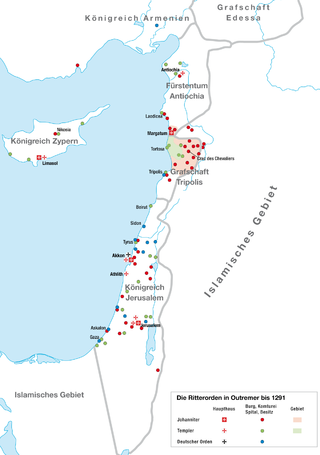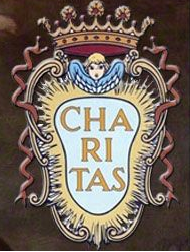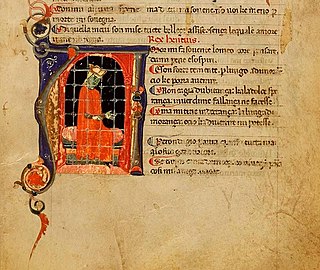
A military order is a Christian religious society of knights. The original military orders were the Knights Templar, the Knights Hospitaller, the Order of Saint James, the Order of Calatrava, and the Teutonic Knights. They arose in the Middle Ages in association with the Crusades, both in the Holy Land, the Baltics, and the Iberian peninsula; their members being dedicated to the protection of pilgrims and Christians, as well as the defence of the Crusader states. They are the predecessors of chivalric orders.

The Guelphs and Ghibellines were factions supporting respectively the Pope and the Holy Roman Emperor in the Italian city-states of Central Italy and Northern Italy during the Middle Ages.

The Minims, officially known as the Order of Minims, and known in German-speaking countries as the Paulaner Order, are a Roman Catholic religious order of friars founded by Francis of Paola in fifteenth-century Italy. The order soon spread to France, Germany and Spain, and continues to exist today.

Mendicant orders are, primarily, certain Roman Catholic religious orders that have adopted for their male members a lifestyle of poverty, traveling, and living in urban areas for purposes of preaching, evangelization, and ministry, especially to the poor. At their foundation these orders rejected the previously established monastic model. This model prescribed living in one stable, isolated community where members worked at a trade and owned property in common, including land, buildings and other wealth. By contrast, the mendicants avoided owning property at all, did not work at a trade, and embraced a poor, often itinerant lifestyle. They depended for their survival on the goodwill of the people to whom they preached. The members of these orders are not called monks but friars.

The Scrovegni Chapel, also known as the Arena Chapel, is a small church, adjacent to the Augustinian monastery, the Monastero degli Eremitani in Padua, region of Veneto, Italy. The chapel and monastery are now part of the complex of the Musei Civici di Padova.

The Battle of Campaldino was fought between the Guelphs and Ghibellines on 11 June 1289. Mixed bands of pro-papal Guelf forces of Florence and allies, Pistoia, Lucca, Siena, and Prato, all loosely commanded by the paid condottiero Amerigo di Narbona with his own professional following, met a Ghibelline force from Arezzo including the perhaps reluctant bishop, Guglielmino degli Ubertini, in the plain of Campaldino, which leads from Pratovecchio to Poppi, part of the Tuscan countryside along the upper Arno called the Casentino. One of the combatants on the Guelph side was Dante Alighieri, twenty-four years old at the time.

The Battle of Montaperti was fought on 4 September 1260 between Florence and Siena in Tuscany as part of the conflict between the Guelphs and Ghibellines. The Florentines were routed. It was the bloodiest battle fought in Medieval Italy, with more than 10,000 fatalities. An act of treachery during the battle is recorded by Dante Alighieri in the Inferno section of the Divine Comedy.

Enzo was an illegitimate son of the Hohenstaufen emperor Frederick II, who appointed him 'King of Sardinia' in 1238. He played a major role in the wars between Guelphs and Ghibellines in the Imperial kingdom of Italy, and was captured by his enemies in 1249. He remained imprisoned in Bologna until his death.

Manente degli Uberti, known as Farinata degli Uberti, was an Italian aristocrat and military leader of the Ghibelline faction in Florence. He was considered to be a heretic by some of his contemporaries, including Dante Alighieri, who mentioned Farinata in his Inferno.

Bethlehemites, or Bethlemites, is the name of five Catholic religious orders. Two of them were restored to existence in the 20th century. The other three are extinct.

The Battle of Fossalta was a battle of the War of the Guelphs and Ghibellines in Northern Italy. It took place in Fossalta, a small location on the Panaro River, and is especially remembered for the capture of Enzio of Sardinia, son of Emperor Frederick II of Hohenstaufen.
The Seven Holy Founders of the Servite Order were seven men of the town of Florence who became bound to each other in a spiritual friendship. They eventually felt called by Mary, mother of Jesus, towards whom they practised an intense devotion. They reported a vision, apparently shared by all separately at the same moment. None of them was aware that the others also had experienced it. The call was to "leave the world, the better to serve almighty God".
Loderingo degli Andalò (1210–1293) was an Italian nobleman from a Bolognese Ghibelline family. He held many important civic positions and founded the Knights of Saint Mary in 1261. Loderingo was the brother of Diana, who founded the Dominican Monastery of Saint Agnes. He was governor of Modena in 1251, and, with Catalano dei Malavolti, shared the position of governor of Bologna in 1265, of Florence in 1266, and of Bologna again in 1267. The Order and the monastery were founded in 1233. The Order, which was approved by Pope Alexander IV in 1261, was the first religious order of knighthood to grant the rank of 'militissa' to women who were the daughter, spouse or widow of a Knight. Its mission was to promote peace between warring municipal factions, but its members soon succumbed to self-interest and it was suppressed by Sixtus V in 1558.
The Crosiers or Brethren of the Cross or crutched friars is a general name for several loosely related Catholic orders, mostly canons regular. Their names derive from their devotion to the Holy Cross. They were founded in the 12th and 13th centuries, during the era of the crusades in the Holy Land. These orders tended to maintain hospitals and care for the sick. Currently, the term "crosiers" most frequently refers to the Canons Regular of the Order of the Holy Cross originating from Belgium, but it could also refer to at least five other orders from Jerusalem, Portugal, Italy, Bohemia, Poland–Lithuania, and a group of friars in England and Ireland.
The Militia of Jesus Christ was a military order in Lombardy during the High Middle Ages. It was founded at Parma by Bartholomew, Bishop of Vicenza, a Dominican, in 1233 and approved by Pope Gregory IX, who gave it a rule in 1234 and placed under the jurisdiction of the Dominicans. Its chief purpose was to combat heresy, like Catharism and Waldensianism, and to strengthen the bond between the Roman Church and the local nobility. In imitation of the Order of Santiago, members of the Militia did not take a vow of chastity, nor did they live communally or in poverty.
The Militia or Order of the (Holy) Faith of Jesus Christ was an ephemeral military order founded in Languedoc in or shortly before 1221. It owed its origins probably to Folquet de Marselha, the Bishop of Toulouse; Simon de Montfort, 5th Earl of Leicester, leader of the Albigensian Crusade; and possibly to Dominic of Caleruega, the founder of the Friars Preachers.
The War of the Bucket or the War of the Oaken Bucket was fought in 1325 between the rival city-states of Bologna and Modena. It took place in the region of Emilia-Romagna, in northern Italy. The war was an episode in the over 300-year-long struggle between Guelphs and Ghibellines. Modena won the Battle of Zappolino, the only battle of the war.
The orders, decorations, and medals of the Holy See include titles, chivalric orders, distinctions and medals honoured by the Holy See, with the Pope as the fount of honour, for deeds and merits of their recipients to the benefit of the Holy See, the Catholic Church, or their respective communities, societies, nations and the world at large.

The third circle of hell is depicted in Dante Alighieri's Inferno, the first part of the 14th-century poem Divine Comedy. Inferno tells the story of Dante's journey through a vision of the Christian hell ordered into nine circles corresponding to classifications of sin; the third circle represents the sin of gluttony, where the souls of the gluttonous are punished in a realm of icy mud.